MicroWriter Redux.
I have decided to publish some of my "archaeological" work from last year on Cy Endfield's MicroWriter. The original objective was to produce a cycle-accurate emulator. I do not currently have the free time to complete this project, so I will post my results here for anyone who might care to pick up the torch. Click on some of the images to see the full-resolution version.
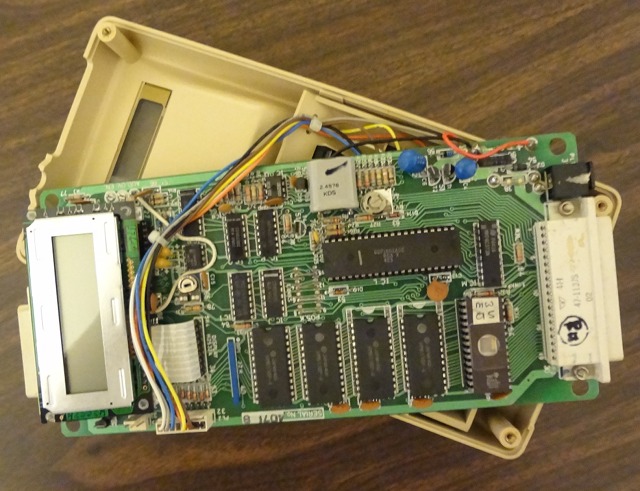
MicroWriter Disassembled.
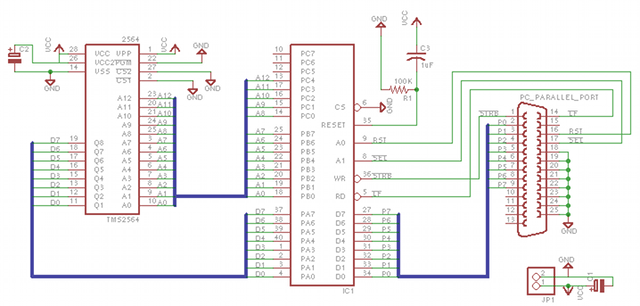
MicroWriter RomSucker Circuit. Easy to build, Applicable to Other Vintage Devices. (Click to view.) IC1 is an '8255A.'
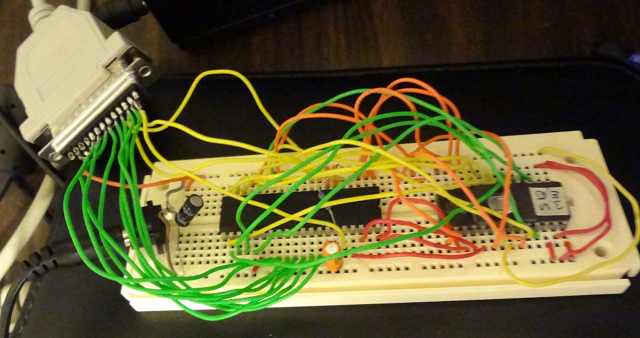
MicroWriter RomSucker (Breadboard.)
- MW Rom Sucker Source Code.
- The extracted ROM itself.
- A history of the CPU used in the MicroWriter. Various versions of the 1802 were used in orbit.
- An attempt at a disassembly.
- A very incomplete emulator.
And now for something completely different:
A very basic web-based emulator of Endfield's chording system. (Supports lower-case alphabet only.)

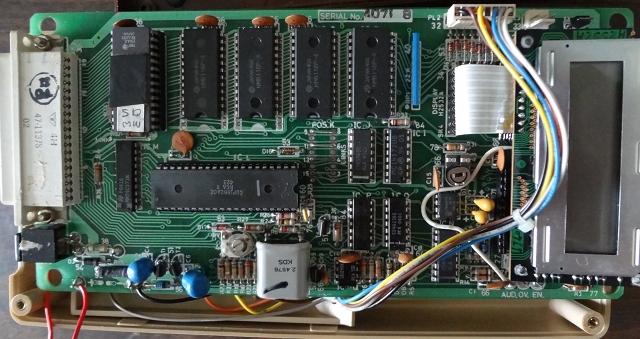
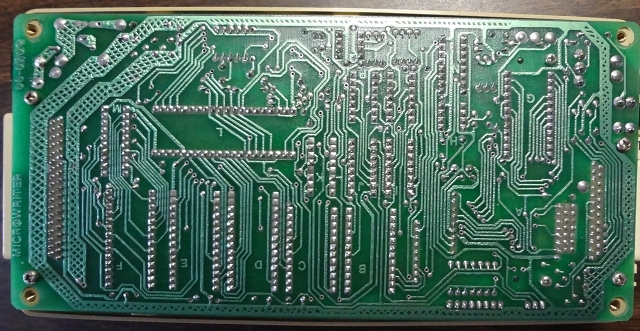
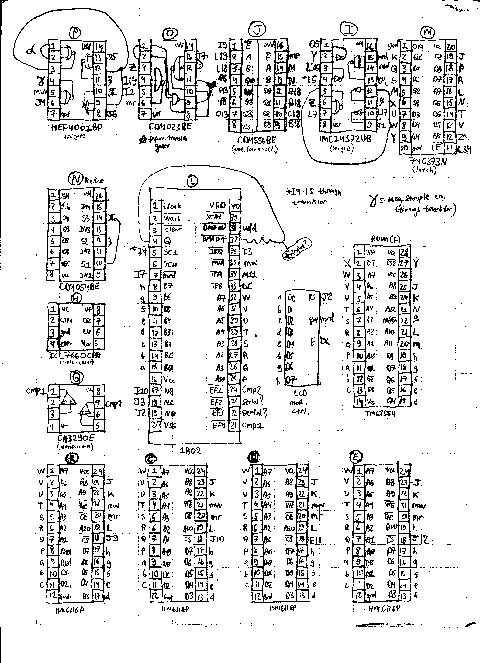
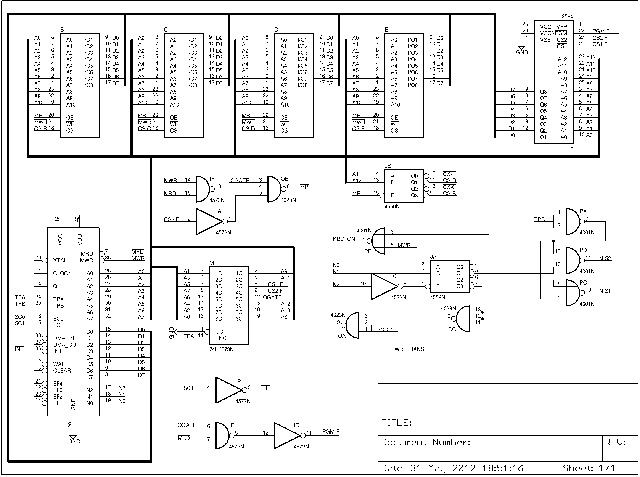
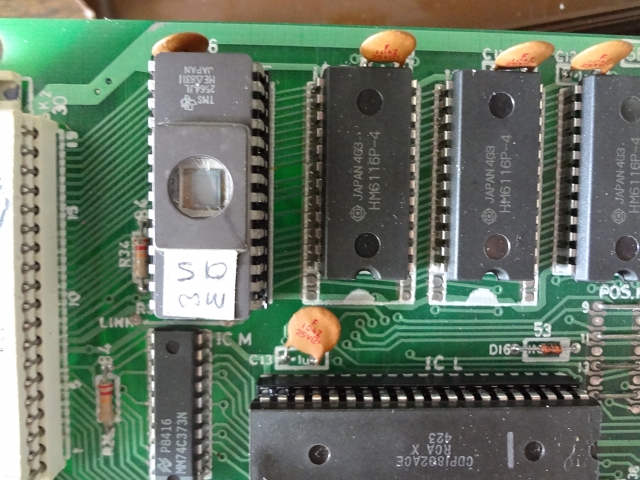


http://loper-os.nfshost.com/wp-content/mwredux/top_all_small.jpg is a PNG file.
Fixed, thanks.
I had no idea that the MicroWriter was powered by the 1802. My first programming job in college was to port the realtime services kernel from a system board powered by the 1802 to one powered by the 6809. This was an eye-opening project for many reasons, but one that sticks with me is the true beauty of the 1802 design. It was in many ways a metaprogrammable CPU (and I don't mean microcode). Needless to say, they don't make them like this anymore.
Very nice post.
Any reason not to learn stenotype? I recognize that the only open-source parsing software is written in Python of all things, but the system seems to have established merit as an input method.
Dear Name,
If you do a good bit of natural-language text entry, by all means try stenotype.
Yours,
-Stanislav
Can you explain how it breaks down when used for programming? Anything resembling Forth is obviously approximately "natural-language text entry", but even with lisp [(][function][-][name][arg][i] seems more efficient than [(][f][u][n][c][t][i][o][n][-][n][a][m][e][ ][a][r][g][ ][i].
Dear Name,
AFAIK, a stenotype is optimized for phonetically-plausible words in a given natural language. This may prove to be an obstacle, or not, depending on your programming language.
Yours,
-Stanislav
More abstractly, stenotype in general is optimized for pronounceable tokens in general, and falls back to mnemonics for punctuation and such. Given natural languages have different orderings of constants, which are used to create letter mappings that mostly preserve them; all the chord(/sequence) to word translations live in a user-specific dictionary file, however, so this is hardly inescapable.
Out of curiosity, would you be willing to post a snippet of "pay the bills" code you've written which isn't amenable to being decomposed into syllables? I know many languages and libraries use identifiers aimed at being easy to type in qwerty, which can be an impediment (especially when you don't have any control over your working namespace), but I've yet to encounter any non-esoteric ones which employ literally random sequences of letters.
Dear fogus,
I've been looking to get into early microprocessor machine language in my quest on applied learning of computer architecture. I've heard much praise of the 1802, as being "light years ahead" in a similar respect to what you've noted, and I was intrigued particularly by your comment that it is "in many ways metaprogrammable". Can you (or indeed, Stanislav, or others) elaborate on what exactly makes the 1802 design metaprogrammable, and why you consider this an eye-opener?
I have always thought that it would be great to have a chording input system for modern tablets , but there wasn't one, so, I have written my own. I call it SiWriter - because my name is Simon and it sounds good.
SiWriter has a website, siwriter.co.uk that links to the Apple App Store download of the three versions I have so far released for the iPad and iPad mini.
I would be delighted if you took a look. It uses all the main codes that Cy Endfield devised plus a few of my own for a mass of other characters.
I have just uploaded a free version of the 'Pro' release, it should be available by next week. Until then, contact me at siwriter@torty.org.uk for a free version of the full Pro release - or, pay $7.99 and download one for yourself.
The current Free version is a stripped down variant of the first release which is still available at $1.99 from https://itunes.apple.com/us/app/siwriter/id693864527?mt=8
The full priced version can be got by clicking here... https://itunes.apple.com/us/app/siwriter-pro-vr-1.0.1.6/id811435990?mt=8
It's easier than building one physically !
Dear Simon,
I am glad that you enjoyed this picture, but unfortunately I do not find myself burning with the desire to use a chording keyboard having no physical keys! Just thinking about it makes my fingers ache. Comfortable keyboards must have moving keys - preferably with buckling springs, as well.
Yours,
-Stanislav
Keeping it short: I have the original Microwriter pictured here, in excellent working condition. In fact several of them. New batteries, tiny screen shows alphanumeric text generated as chorded keys are pressed and released.
Problem is that I have not been able to connect the Microwriter to another device for editing or storage or e-mailing. I have cables, serial to USB that look like they should connect the output of Mw to input of Mac Terminal or "Z-term" but no connection takes place. Can you tell me what I am missing or what I should do to make connection?
Many thanks,
Peter Jacobson
pjcjacobson@gmail.com
510 459-3225
Dear Peter Jacobson,
To be honest, I never tried uploading from mine.
But USB-to-RS232 cables are notoriously unreliable, esp. with vintage hardware that wants low baud rates. Try a genuine serial port.
Yours,
-Stanislav
Delighted to see your reference here to the wonderful Cy Endfield's wonderful Mark IV Microwriter. I was an early user of the Microwriter and later the Agenda, and became adept at chording and never wanted to return to qwerty. I have replaced the rechargeable batteries and have several working microwriters but cannot make the connection to my current Macs, a Macbook. Can you tell me how to do so? I have tried to connect the output jack, RS232c, to a serial adapter such as the keyspan which I used to use with my old MacPlus and a terminal emulator such as Versaterm or vt100 that worked perfectly but now is undetected. I have the instructions and have spent some time trying to connect, but the "print command" that sent text rolling along to a dot matrix printer or the screen of my old Mac - to be saved and opened in any text editor - but now does not come through to the Mac. I thould if would be a terrific way to enter text also on my iPad or iPhone or Android, so I wonder if you could advise me how to proceed. Many thanks,
Peter Jacobson
510 459-3225
they die slowly, as the eprom is not completely lightproof. I bought two and #1 does ok with quite a few bugs, #2 does much less. trey re-burning the eprom. (I am getting round to it). Cy's email worked recently, he didn't come over as wanting to get back in to this technology, but likes compliments, which are due.
Dear robert,
> they die slowly, as the eprom is not completely lightproof
For this reason, I recommend replacing paper stickers on vintage EPROMs (especially in irons one opens up with any regularity) with carefully cut foil tape.
Yours,
-S
I have a microwriter for sale if you are interested
Dear lorraine,
Got one already. (In case this was not clear from the article.)
Yours,
-Stanislav
I am interested in purchasing it. Contact me at my linked website.
I would love to purchase a working "AgendA" as mine will not function. I have two working Microwriter units but have not yet succeeded in making a connection so that the text I chord-typed and can see clearly on the tiny screen can be edited or printed or e-mailed. I will not give up, intuitively I feel it must be possible! Any further suggestions anyone out there?!!!
Peter Jacobson
Continue working on making the connection of Microwriter to editable/ preservable text on a contemporartry computer. Any suggestions gratefully solicited!
Peter
Now into January, 2015, and I wanted to check into this spot and reaffirm that I remain interested in resuscitating the technology described here, encourage anyone who shares this interest to get in touch with me here or directly at -> pjcjacobson@gmail.com
Thanks,
Peter
1802 is indeed a beautiful design to work with. It was the first of it's kind, and it's still unique little piece of hardware. Did you managed to get this work?
Rereading in search for a response I see I was not clear in my request. I have a working Microwriter that I am not able to connect to a Mac to receive the text so as to edit or paste into an email or Evernote,etc. The cable that I used with my old Mac Plus does not work, of course, and the other cables that I have tried that have a usb do not work either.
So my query: How in blazes cam I use my sturdy Microwriter today, what cabe wiil connect and what program to receive the text typed on the Microwriter?
Many thanks for any leads!
Peter
pjcjacobson@gmail.com
10/13/17 - Tempis Fugit
Thought to check in, still hopeful that the iPad used to write this note can be connected to the chorded keypad of the MicroWriter! to provide the direct flow of consciousness from mind/, brain through arm to finger tips and into storage or print. Intuitive, a superior way to unlock creative thought, encouraging the flow of articulated ideas into a medium for editing, contemplation, storage, disdemination.
Has there been any further progress In the Cy Endtfield chording keyboard and system.or expressed interest by someone who might work with us to revitalize it?
My thanks
Peter Jacobson
510 459-3225
pjcj@me.com
Vik Olliver just released a DIY USB Microwriter-like keyboard using at ATMega32u4 microcontroller. Source, with link to a 3d printed case, is here: https://github.com/VikOlliver/Microwriter
Dear scruss,
Neat. But if I were considering such a thing for serious all-day use, would probably want a machined (or at least injection-molded, like the Microwriter's) chassis -- last I knew, typical "3d print" material inescapably has a sandpaper-like texture.
Yours,
-S
Has anyone had any success with reburning the eprom? I have a partially working MW4 and the eprom seems a good place to start, but cannot find an EPROM programmer capable of writing to a TMS 2564 nowadays.
Dear Aiken,
See e.g. here.
Yours,
-S
Thanks Stanislav,
I've been pointed to some success with writing to the 2564 with a GQ-4x. https://forum.vcfed.org/index.php?threads/another-motherboard-not-booting.1248205/
I've just recieved my GQ-4x4 and successfully read the two MW4 chips I have (one is a 2564-35). I saw some big differences in the diffs between the first ROM I read and the one you have shared. I was assuming the expected degrade on my EPROM, but then oddly the second chip I read has a .bin that perfectly matches my first chip, so perhaps there is no degrade and some other issue.
Can you tell me any more about the rom you have? do you know if there were significant version diffrences etc? None of this gets me closer to a working MW4 and the half-good one I have is fine at first and then the display seems to lose sync witth the memory. I am awaiting a replacement 2564 to write to, but will also investigate further to see if it is another problem.
Thanks -A